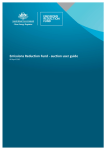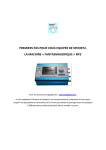Download cryocheck™ FACTOR IX DEFICIENT PLASMA cryocheck
Transcript
CRYOPEP cryocheck ™ Plasma déficient pour le test de coagulation de facteur IX cryocheck ™ cryocheck ™ Procedure Factor Deficient Plasmas FACTOR IX DEFICIENT PLASMA After thawing and preparing cryocheck Factor IX Deficient Plasma, use in accordance with established laboratory procedures for the quantitative assessment of factor IX. Materials Provided Intended Use Factor IX Deficient Plasma is recommended for use as a deficient substrate in clot-based factor IX assays using the activated partial thromboplastin time (APTT). Materials required but not Provided cryocheck Summary and Principle Deficiencies in coagulation factors may have congenital or acquired etiologies and can compromise in vivo hemostasis1. Factor IX (antihemophilic B factor) is a single-chained glycoprotein with a molecular weight of 55,000 - 57,000 Da and is necessary for intrinsic coagulation2. Plasma samples deficient in coagulation factor IX exhibit a prolonged APTT. Factor IX deficiency (hemophilia B) is commonly diagnosed through the use of a modified APTT assay. When a patient sample is mixed with factor IX deficient plasma, the degree of correction of the APTT is proportional to the level of factor IX in the patient plasma3. Reagents Factor IX Deficient Plasma consists of normal citrated human plasma, which has been depleted of factor IX by immunoadsorption. The plasma is then buffered with HEPES buffer, aliquoted, and rapidly frozen. Factor IX has been assayed at less than 1% of normal levels by both functional and antigenic methods. other factors have been assayed and results are provided on the Quality control certificate that accompanies each lot number. cryocheck All blood products should be treated as potentially infectious. Source material from which this product was derived was found to be negative when tested in accordance with current FDA required tests. No known test methods can offer assurance that products derived from human blood will not transmit infectious agents. Accordingly, these human blood based products should be handled and discarded as recommended for any potentially infectious human specimen4. Storage and Handling When stored at -40 to -80°c, cryocheck Factor IX Deficient Plasma is stable to the end of the month indicated on the product packaging. Thaw each vial at 37°c (± 1°c) in a waterbath. The use of a dry bath or heating block for thawing is not recommended. Thawing times are important and should be strictly adhered to. The use of a timer is recommended. refer to the Thawing Table for recommended thawing times based on aliquot size. Allow thawed plasma to acclimate to room temperature (18 to 25°c) and invert gently prior to use. Thawing Table Aliquot Size 37°c (± 1°c) Waterbath 1.0 mL 4 minutes 1.5 mL 5 minutes cryocheck Factor IX Deficient Plasma may be used for up to eight hours after thawing, if capped in the original vial and maintained at 2 to 8°c. Allow refrigerated plasma to acclimate to room temperature (18 to 25°c) and invert gently prior to use. Thawed material should be discarded after eight hours and should not be refrozen. cryocheck Example Only 100 Plasma déficient pour le test de coagulation de facteur IX Factor IX Deficient Plasma Waterbath capable of maintaining 37°c (± 1°c) Assay reagents cacl2 owren’s Veronol Buffer or equivalent coagulation instrument or assay system calibration plasma (e.g. cryocheck Normal reference Plasma) Quality control material (e.g. cryocheck reference control Normal, cryocheck Abnormal 1 reference control, cryocheck Abnormal 2 reference control) 2 cycle log-log graph paper Plastic test tubes (e.g. 12 x 75 mm) Sample cups Plastic disposable pipettes Volumetric pipette Timer Standard curve Preparation Methods may vary according to instrumentation used. consult the instrument manufacturer’s instruction manual for recommended factor assay (intrinsic) protocols. 1. Prepare assay reagents, calibration plasma, and buffer according to manufacturer’s directions. 2. Make serial dilutions of calibration plasma from 1:10 to 1:320 in buffer as follows: Intérêt du Coffret 10 1 catalog # Format Factor IX Deficient Plasma FDP09-10 25 vials x 1.0 mL FDP09-15 25 vials x 1.5 mL 10 Factor Activity (%) 100 Specimen collection and Preparation Patient samples should be collected into 105 - 109 mmol/L sodium citrate dihydrate anticoagulant (3.2%) in a ratio of 9 parts blood to 1 part anticoagulant. Patient plasma is derived by centrifugation at 1500 x g for 15 minutes and should be tested within four hours of collection when maintained at 2 to 4°c in accordance with cLSI guidelines5. Assay Procedure 1. Prepare a 1:10 dilution of patient plasma with buffer. 2. repeat steps 3 through 5 of Standard curve Preparation, substituting diluted patient plasma for diluted calibration plasma. 3. read the percent factor IX activity from the standard curve by finding the point where the clotting time intercepts the curve, then reading the percent factor IX activity off the x-axis. 4. Further dilutions of patient plasma may be prepared and tested to confirm the value. Quality control 1 1.8 mL 0.2 mL calibration plasma 1:10 100 2 1.0 mL 1.0 mL of Tube No. 1 1:20 50 Each laboratory should establish its own quality control (Qc) ranges using acceptable statistical methods. These Qc ranges may then be used to monitor and validate the integrity of the test system6. For all coagulation tests, the laboratory must include at least two levels of control for every eight hours of operation and any time a change in reagents occurs7. 3 1.0 mL 1.0 mL of Tube No. 2 1:40 25 Results 4 1.0 mL 1.0 mL of Tube No. 3 1:80 12.5 5 1.0 mL 1.0 mL of Tube No. 4 1:160 6.25 6 1.0 mL 1.0 mL of Tube No. 5 1:320 3.12 Tube No. Volume Volume of Dilution of Buffer calibration Plasma % Factor Note: This is an example only of a serial dilution profile prepared using calibration plasma with a factor IX level of 100%. Always be sure to utilize the lot-specific factor IX level of the calibration plasma in use. If using cryocheck Normal Reference Plasma, refer to the lot-specific Assay Certificate. 3. Prewarm APTT reagent and calcium chloride to 37°c (± 1°c). 4. To a coagulation reaction cuvette, add 0.1 mL of cryocheck Factor IX Deficient Plasma, 0.1 mL of Tube No. 1 (100% of factor), and 0.1 mL of prewarmed APTT reagent. Mix and incubate according to the manufacturer’s directions. 5. Add 0.1 mL of prewarmed calcium chloride and simultaneously initiate the clot timer. record clotting times in seconds. 6. repeat steps 4 and 5 for Tube No.’s 2 to 6. 7. on log-log graph paper plot clotting times in seconds (y-axis) vs. % of factor IX activity (x-axis). 8. construct the standard curve by drawing the best straight line fit through the plots. Factor IX activity values recovered below the normal range may be indicative of a factor IX deficiency (congenital or acquired). Each laboratory should establish its own normal range for factor IX activity in accordance with cLSI guidelines8. Le cryocheck Factor IX Deficient Plasma est recommandé pour l’évaluation de l’activité du facteur IX par la méthode de dosage du temps de céphaline activateur (TcA) nécessitant l’emploi d’un plasma dépourvu de facteur IX. Résumé et Principe Les déficiences en facteur de coagulation peuvent avoir des origines congénitales ou acquises et peuvent compromettre le processus de l’hémostase in vivo1. Le facteur IX (facteur antihémophilique B) est une glycoprotéine d’un poids moléculaire d’environ 55 000 - 57 000 Da2. Il est nécessaire pour la voie intrinsèque de la coagulation. Les plasmas déficients en facteur IX ont un temps coagulation en présence céphaline activateur (TcA) allongé. Une déficience en facteur IX est couramment diagnostiquée au travers le dosage d’un TcA modifié où tous les facteurs sont présents et en excès à l’exception du facteur IX apporté successivement par les plasmas dilués du témoin et des malades. Dans ces conditions, le degré de correction du TcA est proportionnel au niveau de facteur IX dans le plasma du patient3. Réactifs Le cryocheck Factor IX Deficient Plasma consiste en un pool de plasmas normaux humains citrates, qui a été dépourvu de facteur IX par immuno-adsorption, tamponné avec de l’HEPES, aliquote et congelé rapidement. Le cryocheck Factor IX Deficient Plasma a été validé comme ayant moins de 1% du taux normal, évaluations effectuées à la fois en méthodes fonctionnelles et antigéniques. Les autres facteurs ont été dosés et les résultats sont consignés sur le certificat de contrôle de qualité qui accompagne chaque numéro de lot. Tous les produits sanguins doivent être traités comme potentiellement infectieux. Les matières dont ils dérivent, ont été testées suivants les directives imposées par la FDA. Cependant, aucune méthode connue ne peut offrir l’assurance que les produits dérivés du sang humain ne transmettent pas d’agents infectieux. En conséquence, ces produits issus de sang humain doivent être manipulés et détruits comme préconisés pour tout échantillon potentiellement infectieux4. Limitations of the Procedure conservation et préparation du réactif When proper control values are not obtained, assessment of each component of the test system including reagents, control plasmas, instrumentation and operator technique must be undertaken in order to ascertain that all other components are functioning properly. ce plasma est stable, s’il conservé congelé entre -40 et -80°c, jusqu’à la fin du mois de la date de péremption indiquée sur l’emballage. Expected Values Expected values may vary according to reagent, instrument and technique employed. It is recommended each laboratory establish its own normal range for factor IX activity. Décongeler chaque flacon à 37°c (±1°c) dans un bain-marie. L’utilisation d’un bain sec ou d’un bloc chauffant pour la décongélation n’est pas recommandée. Les temps de décongélation sont importants et doivent être rigoureusement respectés, un chronomètre est recommandé. Se référer aux tables de décongélation basées sur la taille des aliquotes. Laisser les plasmas décongelés se stabiliser à la température ambiante (18 à 25°c) et retourner doucement avant utilisation. Table de Décongélation Performance Characteristics refer to the certificate of Analysis for clotting factor specifications with each lot number of cryocheck Factor IX Deficient Plasma. When used according to recommended methods, results are subject to the limitations of the assay system (i.e. reagents, instrument) in use. Availability Product FACTOR IX DEFICIENT PLASMA Time (sec.) FACTOR IX DEFICIENT PLASMA Instruments Each lab should prepare the local instrument in accordance with the manufacturer’s instructions for use. Distributeur en France : CRYOPEP 83, rue Yves Montand, 34080 Montpellier Tel: 04 67 13 21 00 Taille de l’aliquote Bain-marie à 37°c (± 1°c) 1.0 ml 4 minutes 1.5 ml 5 minutes ce plasma doit être utilisé dans les huit heures suivant la décongélation, s’il est conservé dans son flacon d’origine, à 2 à 8°c. Le matériel décongelé doit être détruit après huit heures et ne doit pas être recongelé. CRYOPEP Disponibilité Produit référence Présentation Factor IX Deficient Plasma FDP09-10 25 flacons de 1.0 ml FDP09-15 25 flacons de 1.5 ml Instruments 5. Ajouter 0.1 ml de cacl2 préchauffé et simultanément commencer la mesure du temps de coagulation. Enregistrer ce temps en secondes 6. répéter les étapes 4 et 5 pour les tubes 2 à 6. 7. Tracer sur papier log-log les temps obtenus sur l’axe des y et le % du taux de facteur IX sur l’axe des x. 8. construire la courbe standard en traçant la meilleure droite passant par tous les points. Performances Bibliography / Bibliographie Se référer au certificat de contrôle de qualité pour les spécifications des facteurs de la coagulation pour chaque numéro de lot de cryocheck Factor IX Deficient Plasma. Quand ils sont utilisés selon les méthodes préconisées, les résultats sont soumis aux limitations propres liées au système de dosage utilisé. 1. Biggs r. Human blood coagulation, haemostasis and thrombosis 3rd ed. oxford: Blackwell Scientific Publications; 1984. 2. Halkier T. Mechanisms in blood coagulation, fibrinolysis, and the complement system. cambridge: cambridge University Press; 1991. 3. Triplett DA, Smith c. routine testing in the coagulation laboratory. In: Triplett DA, editor. Laboratory evaluation of coagulation. Illinois: AScP Press; 1982. p. 28-51. 4. Biosafety in Microbiological and Biomedical Laboratories 5th ed. centers for Disease control and Prevention / National Institutes of Health, 2007. 5. collection, Transport, and Processing of Blood Specimens for Testing Plasma-Based coagulation Assays and Molecular Hemostasis Assays; Approved Guideline-Fifth Edition, cLSI, H21-A5; Vol. 28, No. 5, 2008. 6. cembrowski GS, carey rN. Laboratory quality management. chicago: AScP Press; 1989. p. 166-171. 7. cLIA 2004 – code of Federal regulations, 42cFr493.1269, 2004. 8. Determination of Factor coagulant Activities; Approved Guideline-First Edition, cLSI, H48-A; Vol. 17, No. 4, 1997. chaque laboratoire doit préparer les instruments nécessaires stipulés dans les instructions du fabricant. Après décongélation et préparation du cryocheck Factor IX Deficient Plasma, utilisez, comme décrit, les procédures établies au laboratoire pour des dosages quantitatifs du facteur IX. Matériel fourni cryocheck Factor IX Deficient Plasma Matériels requis mais non fournis Bain-marie (37°c ± 1°c) réactifs de dosage du TcA cacl2 Tampon owren-Koller ou équivalent Instrument de coagulation ou système de dosage Plasma de calibration (ex. cryocheck Normal reference Plasma) Matériel de contrôle qualité (ex. cryocheck reference control Normal, cryocheck Abnormal 1 reference control, cryocheck Abnormal 2 reference control) Pipettes plastiques chronomètre Papier Log-Log Tubes à essai en plastique Tasses à échantillon Pipette volumétrique Préparation des courbes standards La méthode peut varier selon les instruments utilisés. consulter le manuel d’instructions du fabricant d’instrument pour les protocoles de dosages de facteurs. Dans la mesure du possible, tous les essais seront réalisés simultanément. 1. Préparer les réactifs de dosage, les plasmas de calibration et les tampons selon les directives du fabricant. 2. Faire une série de dilutions du plasma de calibration du 1/10ème au 1/320ème dans du tampon owren-Koller comme suit (la dilution au 1/10ème correspond au taux de base): N° Tubes Volume Volume de plasma de Dilution de calibration tampon % Facteur 1 1.8 ml 0.2 ml du plasma de calibration 1/10 100 2 1 ml 1 ml du tube 1 1/20 50 3 1 ml 1 ml du tube 2 1/40 25 4 1 ml 1 ml du tube 3 1/80 12.5 5 1 ml 1 ml du tube 4 1/160 6.25 6 1 ml 1 ml du tube 5 1/320 3.12 Note: Il ne s’agit ici que d’un exemple de dilutions en série préparées avec le plasma de calibration avec un taux de facteur IX de 100%. Toujours s’assurer d’utiliser le lot correspondant au taux de facteur IX du plasma de calibration utilisé. Pour le plasma cryocheck Normal Reference Plasma, voir le Certificat d’analyse sur le lot utilisé. 3. Préchauffer le réactif TcA et le calcium à 37°c ± 1°c. 4. Ajouter 0.1 ml de cryocheck Factor IX Deficient Plasma à la cuvette de réaction de coagulation, 0.1 ml du tube 1 (100%) et 0.1ml du réactif TcA à 37°c. Mélanger et incuber suivant les instructions du fabricant du TcA. Temps de coagulation(s) Exemple de courbe d’étalonnage Procédure 100 10 1 10 100 Facteur activité (%) Prélèvement et préparation Les prélèvements du sang de patients doivent être collectés sur une solution anticoagulante de citrate trisodique (3.2%) de concentration 105 - 109 mmol/l dans un ratio de 9 volumes de sang pour 1 volume d’anticoagulant. Le plasma de patient est obtenu par centrifugation à 1500 x g pendant 15 minutes et doit être testé quatre heures après le prélèvement quand il est maintenu à 2 à 4°c comme convenu dans les instructions du cLSI5. Procédure de dosage 1. Préparer une dilution au 1/10ème du plasma du patient avec du tampon. 2. répéter les étapes 3 à 5 de la Préparation de la courbe standard, en substituant le plasma de calibration dilué par celui du patient. 3. Lire le pourcentage d’activité du facteur IX à partir de la courbe standard en joignant le point où le temps de coagulation intercepte la courbe, on lit alors le pourcentage d’activité du facteur IX sur l’axe des x. 4. Plusieurs dilutions du plasma du patient peuvent être préparées et testées afin de confirmer cette valeur. contrôle de qualité chaque laboratoire doit établir ses propres normes de contrôle qualité en utilisant des méthodes statistiques acceptables. ces normes doivent être utilisées afin de contrôler et de valider l’intégrité des systèmes de test6. Pour tous les tests de coagulation, le laboratoire doit inclure au moins deux niveaux de contrôle toutes les huit heures et en aucun cas, un changement de réactifs ne doit intervenir7. Résultats Les valeurs d’activité du facteur IX trouvées en dessous de la normale peuvent indiquer une déficience en facteur IX (congénitale ou acquise). chaque laboratoire doit établir sa propre gamme pour l’activité du facteur IX en accord avec les instructions du cLSI8. European Authorized representative (regulatory affairs only) Emergo Europe Molenstraat 15, 2513 BH The Hague, The Netherlands Tel: (+31) 70 345 8570 Fax: (+31) 70 346 7299 Limites de la Méthode Quand des valeurs attendues des contrôles ne sont pas conformes, le contrôle de chaque composant du système de mesure (réactifs, plasmas de contrôle, instrument et technique opératoires) doit être effectué afin de s’assurer que tous les composants sont fonctionnellement corrects. Valeurs Attendues Les valeurs attendues peuvent varier suivant les lots de réactifs, les instruments et les techniques employées. Il est recommandé à chaque laboratoire d’établir sa propre gamme normale d’activité du facteur IX. Symbols used / Symboles utilisés 09.60.00023 rev. 11 May / mai 2012 In vitro diagnostic medical device Batch code Use by Temperature limitation Biological risks Manufacturer Authorized representative Dispositif médical de diagnostic in vitro Désignation du lot Date de péremption Températures limites de conservation risque biologique Fabricant Mandataire Precision BioLogic Inc. 140 Eileen Stubbs Avenue Dartmouth, NS B3B 0A9 Canada Tel: 1.800.267.2796 / +1.902.468.6422 Fax: 1.800.267.0796 / +1.902.468.6421 www.precisionbiologic.com Distributeur en France : CRYOPEP 83, rue Yves Montand, 34080 Montpellier Tel: 04 67 13 21 00





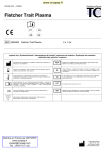


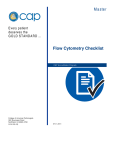
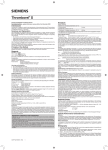
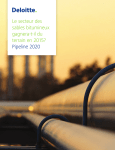
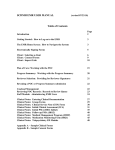
![Stained Proteus Suspensions [FR]](http://vs1.manualzilla.com/store/data/006407012_2-a33fb0113295968d76805e5a7868d2d3-150x150.png)
